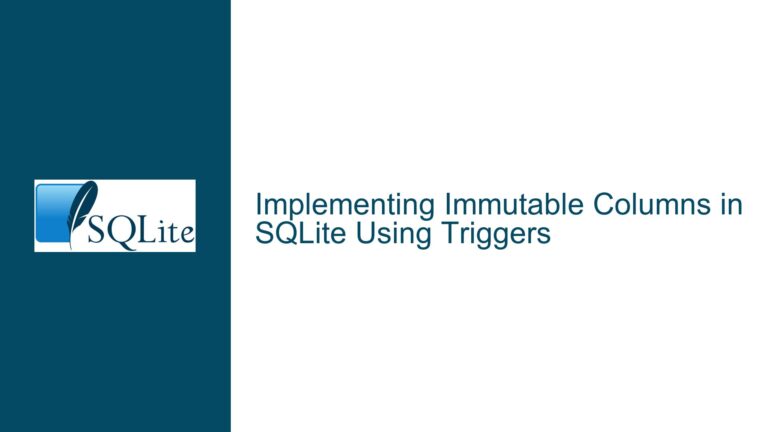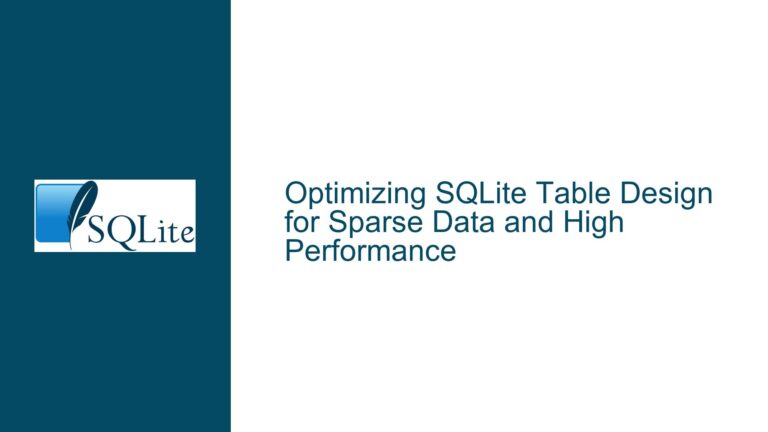Disabling NOT NULL Constraints in SQLite for Data Migration
Understanding the Need to Temporarily Disable NOT NULL Constraints
The core issue revolves around the need to temporarily disable or circumvent NOT NULL constraints in SQLite during a data migration process. This requirement arises when migrating data from a large SQL Server database to a SQLite database, where the schema is replicated using the same migrations as the source database. The migration process involves using an ORM (NHibernate) to copy all entities in two passes: first, all root entities and their non-relational properties, and second, the relationships between the entities.
During the first pass, an exception is thrown due to NOT NULL constraints on foreign key columns. The challenge is that modifying the schema or providing values for these columns is not feasible due to the complexity and scale of the database, which involves hundreds of tables with circular references between entities. The goal is to find a method to temporarily disable or bypass these NOT NULL constraints to facilitate the data migration process without altering the schema or the insertion order.
Exploring the Limitations and Workarounds for NOT NULL Constraints
SQLite provides mechanisms to disable certain constraints, such as PRAGMA foreign_keys = 0; to disable foreign key constraints and PRAGMA ignore_check_constraints = 1; to ignore check constraints. However, neither of these pragmas can disable NOT NULL constraints. This limitation necessitates exploring alternative methods to achieve the desired outcome.
One proposed solution is to create a temporary table that mirrors the original table but lacks the NOT NULL constraints. Data can be loaded into this temporary table, and once all data is inserted, it can be copied back to the original table using the INSERT … SELECT command. This approach, while effective, requires significant manual effort, especially when dealing with hundreds of tables.
Another suggestion is to use a non-NULL token value for the relational properties during the initial insertion. Since foreign key constraints are disabled, inserting a placeholder value that can later be updated in the second pass might be a viable workaround. This method avoids the need to modify the schema or the insertion order but requires careful handling to ensure data integrity.
Additionally, the discussion highlights the potential use of custom CHECK constraints as an alternative to NOT NULL constraints. By defining a CHECK constraint that enforces non-NULL values, it becomes possible to temporarily disable the constraint using PRAGMA ignore_check_constraints = 1;. This approach, while hackish, provides a way to bypass NOT NULL enforcement during the data migration process.
Detailed Troubleshooting Steps and Solutions for Disabling NOT NULL Constraints
To address the issue of temporarily disabling NOT NULL constraints in SQLite, the following detailed steps and solutions can be implemented:
1. Creating Temporary Tables Without NOT NULL Constraints:
- Step 1: Identify all tables with
NOT NULLconstraints on foreign key columns. - Step 2: For each identified table, create a temporary table with the same structure but without the
NOT NULLconstraints. This can be done using theCREATE TABLE … AS SELECTcommand. - Step 3: Load the data into the temporary tables. Since these tables lack the
NOT NULLconstraints, the initial insertion can proceed without errors. - Step 4: Once all data is loaded, use the
INSERT … SELECTcommand to copy the data from the temporary tables back to the original tables. This step ensures that the data is inserted into the original tables with theNOT NULLconstraints enforced. - Step 5: Drop the temporary tables to clean up the database.
2. Using Non-NULL Token Values for Relational Properties:
- Step 1: Identify all foreign key columns with
NOT NULLconstraints. - Step 2: Define a non-NULL token value that will be used as a placeholder during the initial insertion. This value should be unique and easily identifiable.
- Step 3: Insert the data into the tables, using the token value for the foreign key columns. Since foreign key constraints are disabled, this insertion will not raise errors.
- Step 4: In the second pass, update the foreign key columns with the correct values, replacing the token values with the actual foreign key references.
- Step 5: Re-enable foreign key constraints and verify that all relationships are correctly established.
3. Implementing Custom CHECK Constraints:
- Step 1: Identify all columns with
NOT NULLconstraints that need to be temporarily disabled. - Step 2: Replace the
NOT NULLconstraints with customCHECKconstraints that enforce non-NULL values. For example, useCHECK (v IS NOT NULL)orCHECK (typeof(v) <> 'null'). - Step 3: Set
PRAGMA ignore_check_constraints = 1;to temporarily disable theCHECKconstraints during the data migration process. - Step 4: Insert the data into the tables. The custom
CHECKconstraints will be ignored, allowing the insertion of NULL values. - Step 5: After the data migration is complete, set
PRAGMA ignore_check_constraints = 0;to re-enable theCHECKconstraints. - Step 6: Verify that all data adheres to the
CHECKconstraints and that no NULL values are present in the columns that should haveNOT NULLconstraints.
4. Disabling Foreign Key Constraints and Inserting Data in a Single Pass:
- Step 1: Disable foreign key constraints using
PRAGMA foreign_keys = 0;. - Step 2: Insert all data into the tables in a single pass, ignoring the
NOT NULLconstraints on foreign key columns. - Step 3: After all data is inserted, re-enable foreign key constraints using
PRAGMA foreign_keys = 1;. - Step 4: Verify that all foreign key relationships are correctly established and that no
NOT NULLconstraints are violated.
5. Modifying the Schema to Remove NOT NULL Constraints Temporarily:
- Step 1: Identify all
NOT NULLconstraints that need to be temporarily removed. - Step 2: Use a text editor or script to remove the
NOT NULLconstraints from the schema definition. This can be done by modifying the migration scripts or directly editing the SQL schema. - Step 3: Perform the data migration with the modified schema, allowing the insertion of NULL values into the previously constrained columns.
- Step 4: After the data migration is complete, restore the
NOT NULLconstraints by reapplying the original schema definition. - Step 5: Verify that all data adheres to the restored
NOT NULLconstraints and that no NULL values are present in the constrained columns.
6. Using ORM-Specific Solutions:
- Step 1: Evaluate the ORM (NHibernate) configuration to determine if it supports custom handling of
NOT NULLconstraints during data migration. - Step 2: Configure the ORM to use placeholder values or custom insert logic that bypasses the
NOT NULLconstraints during the initial insertion. - Step 3: Perform the data migration using the ORM, ensuring that the custom logic is applied correctly.
- Step 4: After the data migration is complete, update the ORM configuration to enforce the
NOT NULLconstraints and verify data integrity.
7. Handling Circular References Between Entities:
- Step 1: Identify all circular references between entities that complicate the insertion order.
- Step 2: Use a graph traversal algorithm to determine the optimal insertion order that minimizes the impact of circular references.
- Step 3: Implement a multi-pass insertion strategy that inserts entities in the determined order, ensuring that all dependencies are resolved before enforcing
NOT NULLconstraints. - Step 4: Verify that all circular references are correctly resolved and that no
NOT NULLconstraints are violated.
8. Automating the Process with Scripts:
- Step 1: Develop scripts to automate the creation of temporary tables, insertion of data, and restoration of constraints.
- Step 2: Use scripting languages such as Python or Bash to interact with the SQLite database and perform the necessary operations.
- Step 3: Test the scripts on a subset of the data to ensure they work as expected.
- Step 4: Apply the scripts to the entire database, automating the data migration process and reducing manual effort.
9. Validating Data Integrity Post-Migration:
- Step 1: After completing the data migration, perform a thorough validation of the data to ensure that all
NOT NULLconstraints are enforced and that no NULL values are present in the constrained columns. - Step 2: Verify that all foreign key relationships are correctly established and that no orphaned records exist.
- Step 3: Use SQL queries to check for any inconsistencies or violations of constraints.
- Step 4: Address any issues identified during the validation process to ensure the integrity of the migrated data.
10. Documenting the Process for Future Reference:
- Step 1: Document the steps taken to temporarily disable
NOT NULLconstraints and perform the data migration. - Step 2: Include details on the methods used, any scripts developed, and the results of the data validation process.
- Step 3: Store the documentation in a accessible location for future reference, ensuring that the process can be replicated if needed.
By following these detailed troubleshooting steps and solutions, it is possible to temporarily disable or circumvent NOT NULL constraints in SQLite during a data migration process. Each method has its own advantages and considerations, and the choice of approach will depend on the specific requirements and constraints of the migration project.






